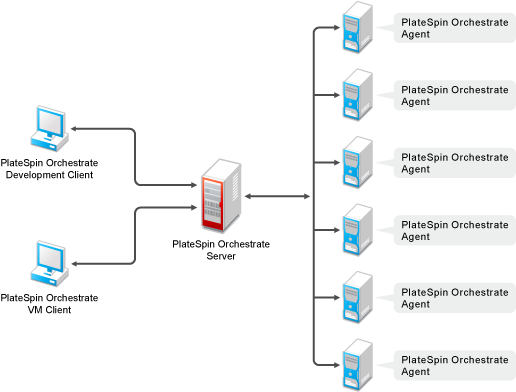2.2 System Architecture
PlateSpin Orchestrate is built as an enterprise server with capabilities to support extremely large computing environments. It includes all the services required to provide an enhanced grid computing application server environment.
A simple view of the PlateSpin Orchestrate system architecture is shown below, showing the PlateSpin Orchestrate software components:
Figure 2-1 PlateSpin Orchestrate Software Architecture

The PlateSpin Orchestrate Server
The PlateSpin Orchestrate Server is the gateway between enterprise applications and resource servers. The server has two primary functions:
-
To manage the resource servers
-
To manage jobs to run on the computing resource
In the first function, the server manages the computing resources by collecting, maintaining, and updating their status availability, service cost, and other facts. Changes to the computing resources can be made by the administrator.
The second function of the server is to run remote applications—called jobs—on the computing resources. The Orchestrate Server uses a policy-based broker and scheduler to decide when and how a job should run on the computing resources. The decisions are based on many controlled factors, including the number of computing resources, their cost, and a variety of other factors as specified by the policy constraints set up by the server administrator. The Orchestrate Server runs the job and provides all the job’s output responses back to the user. The server provides failover capabilities to allow jobs to continue if computing resources and network conditions degrade.
The PlateSpin Orchestrate Agent
The PlateSpin Orchestrate Agent is installed on all computing resources that are to be managed. It runs jobs under the management of the Orchestrate Server.
The PlateSpin Orchestrate Development Client and Other Client Tools
The PlateSpin Orchestrate Clients let a computing resource administrator troubleshoot, initiate, change, or shut down server functions for PlateSpin Orchestrate and its computing resources. The clients also monitor all managed computing resource job activity and provide facilities to manage application jobs. When you install the Clients on a computing resource, you are installing the following tools:
-
zos command line interface
-
zosadmin command line interface
-
PlateSpin Orchestrate Development Client
-
Java* SDK (toolkit)
NOTE:The PlateSpin Orchestrate VM Client is installed separately.
The PlateSpin Orchestrate Development Client is a graphical user interface running on Java. It provides a way for the PlateSpin Orchestrate administrator to troubleshoot and to initiate, change, or shut down the functioning of the Orchestrate Server and its resources. It also functions as a monitor of all PlateSpin Orchestrate job activity, and it provides an interface for managing PlateSpin Orchestrate jobs. For more information about the Orchestrate Development Client, see the PlateSpin Orchestrate 2.0 Development Client Reference.
For more information about the client tools, see Section 2.3, How Do I Interact with PlateSpin Orchestrate?. For more information about the toolkit, see Using the PlateSpin Orchestrate Client SDK
in the PlateSpin Orchestrate 2.0 Developer Guide and Reference.
The PlateSpin Orchestrate VM Client
PlateSpin Orchestrate VM Client is a user interface for managing the life cycle of the virtual machines (VMs) in your enterprise, including creating, starting, stopping, migrating, and deleting VMs. For information about installing the Orchestrate VM Client, see Installing the Orchestrate VM Client
in the PlateSpin Orchestrate 2.0 Installation and Configuration Guide.
The PlateSpin Orchestrate Server Portal
The PlateSpin Orchestrate Server Portal is a web-based user interface for managing jobs. It provides end users with the ability to start and monitor jobs on managed computing resources. For more information about the Server Portal, see Using the PlateSpin Orchestrate Server Portal
in the PlateSpin Orchestrate 2.0 Server Portal Reference.